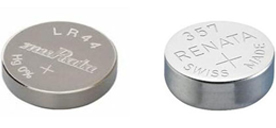Is there a difference between CR2016 and CR2032 batteries?
2024/6/25 15:31:33
Views:
Coin-type button batteries, such as CR2016 and CR2032, are part of the CR series and are commonly found in a wide range of small electrical devices. Although they are similar, they differ in important ways that determine whether or not they can be used interchangeably. Both the CR2016 and CR2032 batteries share a cylindrical shape and a standard diameter of 20 mm, allowing them to physically fit into the same battery compartments of devices. However, a detailed comparison of their specifications, voltage, thickness, chemistry, and additional features reveals some distinct variations.
CR2016 vs CR2032: Batteries What are the Differences?
What is a CR2016 battery?
The CR2016 is a non-rechargeable manganese-lithium button cell battery. It is frequently found in tiny electronic gadgets like watches, calculators, and some kinds of medical gear like digital thermometers. The "CR" prefix stands for the manganese dioxide-lithium chemistry. The battery has a diameter of 20 mm, a height of 1.6 mm, and a nominal voltage of 3 volts. These batteries are appreciated for their long shelf life, high energy density, and ability to operate over a wide temperature range.
What is a CR2032 battery?
A common kind of coin cell battery found in many small electrical gadgets is the CR2032. It is named for its dimensions, being approximately 20 millimeters in diameter and 3.2 millimeters thick. This battery is non-rechargeable and uses lithium chemistry, which offers a long shelf life and stable voltage output. With a typical voltage of 3 volts, the CR2032 is commonly found in gadgets like watches, calculators, fitness appliances, and medical devices such as heart rate monitors. Its compact size and reliability make it a go-to choice for devices that require a small, long-lasting power source.
CR2016 vs. CR2032 Specifications
CR2016 battery Application
1. Electronic Devices
● Watches: CR2016 batteries are commonly used in both digital and analog wristwatches because of their thin profile and long-lasting power.
● Calculators: Many small pocket calculators utilize CR2016 batteries to maintain a slim design while providing sufficient power for prolonged use.
2. Health Care Equipment
● Digital Thermometers: Because they can function consistently across a broad temperature range, these batteries are recommended for use in digital thermometers.
● Hearing Aids: The compact size and durability of CR2016 batteries make them suitable for small, electronic hearing aids.
3. Automotive Applications
● Key Fobs: Car key fobs use CR2016 batteries to power the remote control functions, such as locking, unlocking, and panic alarms.
● Tire Pressure Monitoring Systems (TPMS): Some TPMS sensors use CR2016 batteries due to their long life and resistance to temperature fluctuations.
4. Security and Safety Devices
● Smoke Detectors: In some compact models, CR2016 batteries are used to ensure they remain lightweight and easy to install.
● Security Tokens: Many electronic security tokens powered by CR2016 batteries generate one-time passcodes for secure user authentication.
5. Memory Backup
● Computers and Servers: They provide memory backup power to preserve date, time, and system settings in computers and servers during power outages.
6. Entertainment
● Portable Games: Small handheld electronic games often use CR2016 batteries for their ability to power devices for extended periods without needing frequent replacements.
7. Wearable Technology
● Fitness Trackers: These devices utilize CR2016 batteries for their efficiency and the minimal space they occupy, allowing for sleeker, lighter designs.
CR2032 battery Application
1. Consumer Electronics
● Remote Controls: Many household remote controls, such as those for TVs and air conditioners, use CR2032 batteries because they offer a long life in devices with intermittent usage.
● Watches: Especially in devices that require more power, such as smartwatches, the CR2032 batteries are preferred due to their extended life.
2. Medical Devices
● Glucose Meters: These batteries are ideal for handheld medical devices like glucose meters, where reliability and capacity are crucial for regular monitoring.
● Portable Medical Monitors: Devices such as heart rate monitors and oximeters use CR2032 batteries for their compact size and dependable power.
3. Fitness and Wellness
● Fitness Trackers: The extended life of CR2032 batteries is beneficial for devices like fitness trackers, which need to continuously monitor activity without frequent battery changes.
● Smart Scales: Many modern bathroom scales incorporate CR2032 batteries to handle regular use and maintain precision over time.
4. Automotive and Security
● Car Key Fobs: The CR2032 batteries are widely used in car key fobs for their ability to withstand extreme temperatures and provide reliable performance over years.
● Garage Door Openers: Their long-lasting power makes them suitable for garage door remote controls, ensuring consistent operation.
5. Computing and Office Equipment
● Wireless Mice and Keyboards: These common office devices often use CR2032 batteries to reduce the frequency of replacements, enhancing user convenience.
● Motherboard BIOS Backup: Many computer motherboards use a CR2032 battery to keep the system clock and BIOS settings intact when the main power is off.
6. Entertainment and Leisure
● Electronic Toys: CR2032 batteries power various electronic toys, providing safety through a secure, enclosed battery compartment.
● Portable Gaming Devices: Some small gaming devices use CR2032 batteries for their balance of size and power, making them ideal for travel.
7. Specialty Applications
● LED Tea Lights: For small decorative lights, CR2032 batteries offer the necessary longevity and compact form factor.
● Wearable Lights: Headlamps and other wearable lights often use CR2032 batteries for their lightweight and capacity, important for extended use.
CR2016 vs. CR2032: Difference Between
The CR2016 and CR2032 are both coin cell batteries, commonly used in small electronic devices like watches, calculators, and car key fobs. Despite their similar appearances and functionalities, there are several key differences between the two.
Diameter and Thickness
CR2016: This battery measures 20mm in diameter and 1.6mm in thickness, which explains the '2016' in its name (20mm x 1.6mm).
CR2032: Slightly thicker than the CR2016, this battery also measures 20mm in diameter but is 3.2mm thick. The '2032' denotes its dimensions (20mm x 3.2mm).
Capacity and Voltage
Voltage: Both the CR2016 and CR2032 have the same voltage of 3 volts, which is typical for lithium coin cells.
Capacity: There is a significant difference in capacity between the two. The CR2032 generally offers around 240 mAh (milliampere hours), while the CR2016 provides about 90 mAh. This means the CR2032 can store more energy and is suitable for devices that require longer battery life.
Applications
CR2016: Due to its thinner profile, the CR2016 is ideal for smaller, slimmer devices where space is limited. It's often used in thinner wristwatches, small calculators, and some healthcare devices.
CR2032: This battery's larger capacity makes it more suitable for devices that have higher power demands or are used more frequently. It is commonly used in computer motherboards as a CMOS battery, portable medical devices, and higher-end digital watches.
Compatibility and Interchangeability
Although both batteries have the same diameter, they are not interchangeable due to their difference in thickness. Devices designed for a CR2032 battery will not properly accommodate a CR2016 due to the gap in the battery compartment, potentially causing issues like loose connections that can lead to device malfunction.
Durability and Shelf Life
Both types typically offer similar shelf lives of up to 10 years due to the stable lithium technology used in their manufacture. However, the actual operational life once in use can vary greatly depending on the device's energy demands.
CR2016 vs. CR2032: Similarities Between
The thickness of the CR2016 and CR2032 may vary, but they are identical in some ways. They are both 3 volt versions and both are non-rechargeable. Since the voltage is the same, the CR2016 and CR2032 are interchangeable in some cases. However, since they have different capacities, and therefore different run times, this can cause problems. The CR2016 cannot provide the amount of power that the CR2032 provides, and some devices may not even work properly.
Conclusion
while CR2016 and CR2032 batteries might appear similar at first glance due to their identical voltages and cylindrical shapes, their differences in size and capacity have significant implications for their practical applications and interchangeability. The CR2032's thicker and more capacious design makes it suitable for more power-intensive devices or those requiring longer battery life, whereas the thinner CR2016 is ideal for more compact and low-power devices. Understanding these nuances can help users make informed choices about which battery type is best suited for their specific needs. To ensure optimum performance and longevity of both your smartphone and the battery itself, always take into account the characteristics of the battery and the needs of your device before making a substitute.
WARNING
■ Prevent short circuits and charge between "+" and "-".■ Prevent damage, fire, and overdischarge.
■ In less than 5 seconds, finish sealing at 200°C to 250°C.
■ After discharging the battery to the cut-off voltage, remove it and either bury it underground or dive into deep water.
Common Queries Answered
1. What distinguishes CR2032 batteries from CR2016 batteries?
The primary distinctions between the CR2032 and CR2016 batteries are their sizes and capacities. The CR2032 is 3.2mm thick and usually has a capacity of around 240 mAh, while the CR2016 is 1.6mm thick with a capacity around 90 mAh. Both are 20mm in diameter.
2. Can a CR2032 battery be replaced by a CR2016?
Technically, a CR2016 can fit in a device designed for a CR2032 due to the same diameter, but it will have a shorter life due to its lower capacity. Also, the reduced thickness can lead to poor contact in the battery compartment.
3. How long do CR2032 and CR2016 batteries last?
The lifespan depends on the device usage. Generally, CR2032 lasts longer due to its higher capacity, often up to 4 years in low-drain devices, whereas CR2016 may last about 2 years under similar conditions.
4. What devices typically use CR2032 batteries?
CR2032 batteries are commonly used in remote controls, CMOS batteries in computers, medical devices like heart rate monitors, and small LED flashlights.
5. How much does a CR2016 battery cost?
Depending on the brand and quantity bought, the price can change significantly.
6. How do you correctly install a CR2032 battery?
Ensure the device is turned off. Place the battery in the container according to the instructions, making that the positive (+) side is facing up.
7. What are typical applications for CR2016 batteries?
CR2016 batteries are commonly used in calculators, watches, and car keys because of their thin profile.
8. What is the best storage method for CR2032 batteries?
Keep them out of direct sunlight and in a cool, dry area. Store them in a battery storage box or in their original packaging to prevent short connections.
9. How do you safely dispose of used CR2016 batteries?
Don't discard them in the garbage. Bring them to a store that provides recycling services or to a facility that recycles batteries.
10. Where can I get batteries for the CR2032 and CR2016?
Typically, supermarkets, icwhale.com, electronics stores, and certain convenience stores carry these batteries.
Related Information
-
-
Phone
+86 135 3401 3447 -
Whatsapp








